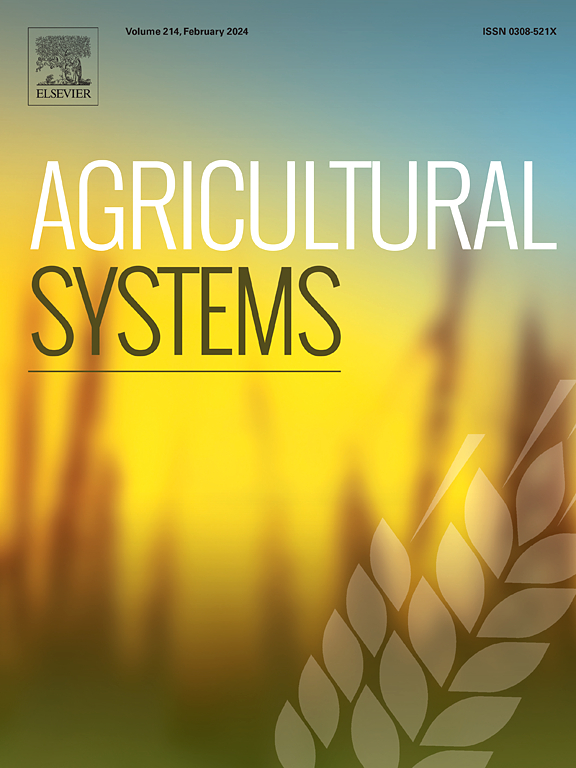Determinants of farm household resilience and its impact on climate-smart agriculture performance: Insights from coastal and non-coastal ecosystems in Odisha, India
IF 6.1
1区 农林科学
Q1 AGRICULTURE, MULTIDISCIPLINARY
引用次数: 0
Abstract
Context
Climate change presents severe challenges to agricultural production systems, particularly for smallholder farmers in developing nations like India. Strengthening the resilience of farm households is crucial for sustaining agricultural productivity in the face of climatic uncertainties. To enhance the effectiveness and upscaling of Climate Smart Agriculture (CSA) interventions, agricultural systems must be restructured and reformed considering resilience of farm households. Understanding the influencing factors of farm household resilience as well as effect of resilience pillars in improving the CSA performance is essential.
Objective
Present study aims to identify the key determinants of farm household resilience across coastal and non-coastal ecosystems in Odisha, India, a highly climate-vulnerable state. It seeks to analyse the interrelationships between resilience determinants and explore the link between farm household resilience and CSA performance in terms of effectiveness and implementation feasibility as perceived by the farmers.
Methods
The study investigates the resilience of farm households across coastal and non-coastal ecosystems, focusing on three dominant livelihood groups: crop farming, livestock farming, and combined crop-livestock farming. It employs the Resilience Index Measurement and Analysis (RIMA) framework to assess resilience through four key pillars: Access to basic services (ABS), Assets (AST), Social safety nets (SSN), and Adaptive capacity (AC). A Multiple Indicators Multiple Causes (MIMIC) model is used to examine resilience determinants, while Structural Equation Modeling (SEM) is applied to assess the relationship between household resilience and CSA performance. Additionally, multiple regression and path analysis are conducted to identify resilience drivers in terms of livelihood indicators across coastal and non-coastal ecosystems.
Results and conclusions
Findings indicate that crop-livestock farming households exhibit the highest resilience in both coastal and non-coastal regions, while crop farmers demonstrate higher resilience than livestock farmers. The study uncovers distinct resilience drivers between coastal and non-coastal areas. SEM analysis highlights a differential relationship between resilience and CSA performance, revealing how resilience influences CSA outcomes. It suggests a moderately fit model highlighting AC and SSN pillars contributing to resilience. Multiple regression and path analysis have revealed key livelihood indicators (such as infrastructure, connectivity, community network, landholding, irrigation access, and income) determining the resilience of the farmers. These insights contribute to a deeper understanding of micro-level resilience among farm households and its relationship with CSA performance.
Significance
By identifying key resilience determinants beyond traditional adaptive capacity, this study provides critical policy inputs for fostering climate-resilient agri-food systems. The findings emphasize the need for targeted interventions to strengthen farm household resilience and promote sustainable, climate-smart agricultural practices in vulnerable regions.

农户抵御力的决定因素及其对气候智慧型农业绩效的影响:来自印度奥里萨邦沿海和非沿海生态系统的见解
气候变化给农业生产系统带来了严峻的挑战,尤其是对印度等发展中国家的小农。面对气候的不确定性,加强农户的抵御能力对于维持农业生产力至关重要。为了提高气候智慧型农业(CSA)干预措施的有效性并扩大其规模,必须考虑到农户的抵御能力,对农业系统进行重组和改革。了解农户弹性的影响因素以及弹性支柱在提高农户综合决策绩效中的作用是必要的。本研究旨在确定印度奥里萨邦沿海和非沿海生态系统农户复原力的关键决定因素,这是一个高度气候脆弱的州。它旨在分析弹性决定因素之间的相互关系,并探讨农户弹性与CSA绩效之间的联系,即农民所感知的有效性和实施可行性。方法研究考察了沿海和非沿海生态系统农户的复原力,重点研究了三个主要的生计群体:种植业、畜牧业和种植业-畜牧业结合。它采用弹性指数测量与分析(RIMA)框架,通过四个关键支柱评估弹性:获得基本服务(ABS)、资产(AST)、社会安全网(SSN)和适应能力(AC)。多指标多原因(MIMIC)模型用于检验弹性决定因素,而结构方程模型(SEM)应用于评估家庭弹性和CSA绩效之间的关系。此外,通过多元回归和路径分析,确定了沿海和非沿海生态系统生计指标的弹性驱动因素。结果与结论研究发现,在沿海和非沿海地区,种植户的抗灾能力最高,种植户的抗灾能力高于养殖户。该研究揭示了沿海地区和非沿海地区之间不同的弹性驱动因素。扫描电镜分析强调了弹性和CSA绩效之间的差异关系,揭示了弹性如何影响CSA结果。它提出了一个适度拟合的模型,突出了AC和SSN支柱对弹性的贡献。多元回归和路径分析揭示了决定农民抗灾能力的关键生计指标(如基础设施、连通性、社区网络、土地持有、灌溉渠道和收入)。这些见解有助于更深入地了解农户微观层面的弹性及其与CSA绩效的关系。通过确定传统适应能力之外的关键抵御力决定因素,本研究为培育气候适应型农业粮食系统提供了关键的政策投入。研究结果强调,需要采取有针对性的干预措施,以增强农户的抵御能力,并在脆弱地区推广可持续的气候智能型农业做法。
本文章由计算机程序翻译,如有差异,请以英文原文为准。
求助全文
约1分钟内获得全文
求助全文
来源期刊

Agricultural Systems
农林科学-农业综合
CiteScore
13.30
自引率
7.60%
发文量
174
审稿时长
30 days
期刊介绍:
Agricultural Systems is an international journal that deals with interactions - among the components of agricultural systems, among hierarchical levels of agricultural systems, between agricultural and other land use systems, and between agricultural systems and their natural, social and economic environments.
The scope includes the development and application of systems analysis methodologies in the following areas:
Systems approaches in the sustainable intensification of agriculture; pathways for sustainable intensification; crop-livestock integration; farm-level resource allocation; quantification of benefits and trade-offs at farm to landscape levels; integrative, participatory and dynamic modelling approaches for qualitative and quantitative assessments of agricultural systems and decision making;
The interactions between agricultural and non-agricultural landscapes; the multiple services of agricultural systems; food security and the environment;
Global change and adaptation science; transformational adaptations as driven by changes in climate, policy, values and attitudes influencing the design of farming systems;
Development and application of farming systems design tools and methods for impact, scenario and case study analysis; managing the complexities of dynamic agricultural systems; innovation systems and multi stakeholder arrangements that support or promote change and (or) inform policy decisions.
 求助内容:
求助内容: 应助结果提醒方式:
应助结果提醒方式:


